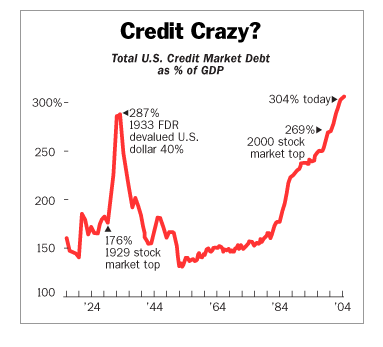
Charles alludes to a 40-year cycle of boom and bust:
Hmm, calling in loans, 1893, calling in busted CDOs, 2007... and did you notice the 40-year cycle of recession/depression? 1890, 1930, 1970, 2010.
He starts with the Panic of 1893 and goes forward:
Let's look at the similarities between then and now:
1. 1893: Massive debt-fueled speculation. Railroads and other speculative ventures (yes, they overbuilt railroads in the late 1800s, just like they overbuilt the Internet in 2000) were all financed with debt-- heavily leveraged debt. No money down, no assets, just paper and promises. Sound familiar?
2. 1929: Massively leveraged speculation. In the Roaring 20s, you could buy $1,000 worth of stock with only $100--a 10% margin requirement. Now, CDOs and other derivatives are leveraged 10 times or even 20 times. A drop of only 5% in the underlying security/mortgage/bond thus spells ruin for the 20X leveraged derivative.
3. 1970: Rising energy costs, deficits and inflation, war, stagflation. The "guns and butter" policies of the late 60s and 70s (paying for a horrendously expensive foreign war and a global Cold War, while lavishing massive Federal entitlements on millions of citizens) created unprecedented deficits and inflation which despite various manipulations (the Feds started the bogus practice of "core inflation") began to run away from policy makers and consumers alike until interest rates were ratcheted up to 16% in 1981.
The oil shocks of 1973 and 1980 sent energy costs to multiples of previous costs--just as oil has risen from $10/barrel in 1998 to $74/barrel today. This combination of inflation, spiraling energy costs and business cycle slowdown created a decade of malaise and stagflation.
4. 2010: Nowhere to hide for investors. The 1970s were a decade of decline for both stocks and bonds, especially when adjusted for inflation. Real estate faired better, as did gold, as "tangibles" were viewed as hedges against a sinking dollar. However, with the World's Greatest real estate bubble now deflating, real estate is not the "undiscovered hedge" it was in the 70s.
...
The root cause of all financial panics and depressions is of course runaway borrowing/skyrocketing debt, risk and leverage. Is the U.S. economy heading for a Great Unraveling? This chart suggests there is no other possible outcome for a debt/leverage/risk expansion which now far outstrips the stupendous imbalances of 1929.
I don't know how strong the connection is on the 40 year cycle as 1970 doesn't sound as bad as the other two. Furthermore, when I typed panic of 1893 into Answers.com, there were multiple banking panics before 1900 (and there wasn't one in 1850). But that 304% credit market debt is certainly cause for alarm.
5 comments:
Hi Fred:
Just a couple of additional comments on Panics and the 1970s:
Yes there were bank panics in 1907 and even in the 1870s, but the one in 1893 was a speculative bust of debt which lasted for 3 years and caused tremendous pain all around, as it was the bust of the decades long railroad overexpansion. People built railways nobody needed just to get in the boom.
The 1970s was a drawn-out period of extreme pain. I vividly remember being a starving college student in 1973 (yes, I had a part-time job at a tourist place) that GM laid off 100,000 workers in one swoop after the oil shortage hit that year.
The stock market lost 30% of its value as it stayed flat and inflation raged. High interest rates destroyed millions of jobs and by the 1980-82 recession, 15% of the workforce was unemployed (officially it was 10%).
Thanks for the link, and the discussion--
charles
304% credit market debt, omg.
Now, that IS scary...
Maybe it takes 40 years for the voters to forget the mess the Republicans got them into the last time.
This prediction is looking right on the monet here 9/27/2008.
still on the money.
depression late 2009 or 2010
Post a Comment